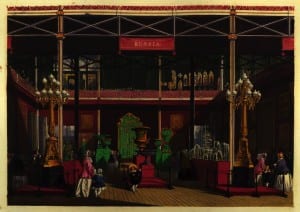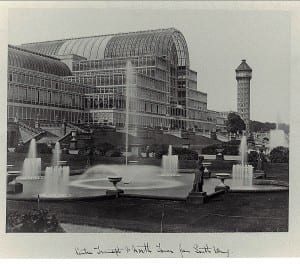Crystal Palace (F. C.): Chernyshevsky’s barmy army
By Sarah J Young, on 30 May 2013
Sarah J. Young finds a rich history of Russian connections to the Crystal Palace, the glass and iron building by Joseph Paxton for London’s 1851 Great Exhibition.
When one thinks of Russian connections to English football, it is most likely the owners and shareholders of certain premier league clubs that will to spring to mind, or the small number of Russians who have played for English clubs, including Roman Pavlyuchenko and Andrei Arshavin. But as Crystal Palace F. C. reaches the premiership following a tense play-off final against Watford, the status of the club as possibly the only one in the English league to be named after a building – its former nickname the Glaziers emphasizing the connection to the iconic structure, which still features on the club badge – provides a legacy of historical and literary Russian resonances that far outstrip the transient presence of mere players and owners, or indeed football itself.
The Great Exhibition was intended, among other things, to bring together the industry of all nations for the promotion of peace and free trade (whilst, inevitably, demonstrating the superiority of Britain in all regards). The Russian exhibit drew attention owing to its late arrival, and was notable for the malachite products that stood out in a display mainly consisting of raw materials.
But in a climate of general xenophobia and fear of foreign revolutionaries who might visit the Exhibition – which took place three years after the 1848 wave of European revolutions – as well as intensifying Russophobia (the Crimean War was only two years away), it is perhaps not surprising that Russians themselves, as much as their manufactures, were seen to be on display. Among the exotic foreigners caricatured in descriptions and cartoons, the fearsome ‘Don Cossack’ always had his place alongside the Chinese mandarin and the African ‘savage’, reminding us how alien and un-European Russians seemed to the British imagination at that time. The notion of the palace as an international space may also have been behind the visit of Tsar Alexander II in 1874. As a later cigarette card commemorating the event indicates, the emphasis on this occasion was reconciliation and sameness – the Russians in the royal entourage pictured here are indistinguishable from the British guests – but the commentary on the reverse reminds us of that ‘other’, alien Russia, ending ominously: ‘The Tsar was assassinated by Nihilists on 13th March 1881.’
But if British views of Russians at the Great Exhibition simply reflected contemporary events and attitudes, within Russian literature the Crystal Palace assumed a particular significance, as it became a touchstone for debates about modernity, westernization and social transformation. Reports in the Russian periodical press throughout the exhibition itself indicate the level of interest in events in London (see my website for reports from one of the major radical journals, The Contemporary), but it was somewhat later, after the Crystal Palace was dismantled and rebuilt on Sydenham Hill in South London, that it acquired this additional dimension, when it became the subject of a famous dispute between Dostoevsky and his main radical opponent, Nikolai Chernyshevsky, the effective founder of Nihilism as an intellectual (not as a bomb-throwing) movement. In July 1854, Chernyshevsky wrote a detailed and glowing review of the reopening of the Crystal Palace in the journal Fatherland Notes, describing it as ‘a miracle of art, beauty and splendour’, and claiming that ‘there has not been a single voice that would be raised against the Palace itself, against its idea and its execution’.
But Chernyshevsky is most renowned for his depiction of the Crystal Palace as the dream of the utopian future of joyful work, communal living, gender equality and free love in his 1863 novel What is to be Done?:
A building, a huge, huge building, such as only exists in a few of the biggest capitals — or rather, no, there’s no other building like it! … But this building — what on earth is it? What style of architecture? There’s nothing like it now; no, there is already one that hints at it – the palace that stands on Sydenham Hill: cast iron and glass, glass and cast iron — nothing else.
Chernyshevsky’s vision of the Crystal Palace as an all-embracing, universal idea and the pinnacle of ‘rational egoism’ (his version of Benthamite utilitarianism), was not the first utopia depicted in Russian literature – that title probably goes to the reactionary writer Faddei Bulgarin’s Untrue Un-Events, or A Voyage to the Centre of the Earth (1824) – but it was certainly the most significant in popularizing the terms of the debate, and it became central to Dostoevsky’s critique of rationalism and radicalism. In both Winter Notes on Summer Impressions (1863 – written before Chernyshevsky’s novel was published) and Notes from Underground (1864), the Crystal Palace is rejected because of the very certainty and finality inherent in its universality:
you become aware of a colossal idea; you feel that something has already been achieved here, that there is victory, triumph here. It’s even as if you begin to feel afraid of something. No matter how independent you are, for some reason you feel terrified. ‘Hasn’t the ideal already been achieved?’ you think, ‘isn’t this the end? isn’t this already in fact “a single herd.” Aren’t you forced, in fact, to accept this as the full truth and grown numb once and for all?’ (from Winter Notes)
The inhumanity of this vision is emphasized by the underground man, as it contradicts the freedom necessary to maintain one’s individuality, and thus leads ultimately to slavery. But while on the one hand, ‘In the crystal palace [suffering] is inconceivable: suffering is doubt, negation, and what sort of crystal palace would it be where doubt was allowed?’ (Notes from Underground), on the other, the human need for individuality means that the Crystal Palace cannot be achieved: ‘I’m convinced that man will never renounce real suffering, that is, destruction and chaos.’
Dostoevsky pursues the humorous side of this topic in his satirical short story ‘The Crocodile’ (1865), a merciless parody of the Russian fashion for progressive western ideas set in the ‘Passazh’, an iron and glass arcade off Nevsky Prospekt in St Petersburg that echoes the Crystal Palace. But the full dystopian implications of his critique are elaborated in Evgeny Zamiatin’s novel We (1921), in which the inhabitants of the ‘One State’ live their rational, useful and ordered lives in full public view in a glass city. Here, the utilitarian foundations of Chernyshevsky’s utopian vision elide with another of Jeremy Bentham’s most famous ideas: the panopticon, the construction enabling total surveillance that transforms the Crystal Palace from a mode of seeing to a mode of being seen.
All of which takes us a long way from football, but with a topic this rich, who needs football? George Orwell gives a rather unsettling perspective on that question in 1984, a novel that was significantly influenced by Zamyatin’s We:
So long as they [the Proles] continued to work and breed, their other activities were without importance. Left to themselves, like cattle turned loose upon the plains of Argentina, they had reverted to a style of life that appeared to be natural to them, a sort of ancestral pattern…Heavy physical work, the care of home and children, petty quarrels with neighbours, films, football, beer and above all, gambling filled up the horizon of their minds. To keep them in control was not difficult.
Football has long been considered the opium of the people (it was used as a means of control in Franco’s Spain, for instance). So Dostoevsky was right, it seems. If he were writing The Brothers Karamazov today, would the enslaved masses be in thrall not to the Grand Inquisitor and Christ moulded in his image, but to the likes of Sir Alex Ferguson and David Beckham? Maybe. But perhaps the ball would break one of the windows of the Crystal Palace and challenge that universal ideal.
Sarah J. Young is a lecturer in Russian at UCL SSEES. She researches Dostoevsky, the Petersburg text, 19th century Russian radicals in London, and Gulag narratives. She developed a particular interest in the image of the Crystal Palace in Russian literature and beyond after moving to London SE19. She blogs at sarahjyoung.com.
Note: This article gives the views of the author(s), and not the position of the SSEES Research blog, nor of the School of Slavonic and East European Studies, nor of UCL.
 Close
Close




